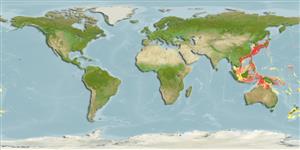Пластиножаберные (акулы и скаты) (sharks and rays) >
Carcharhiniformes (Ground sharks) >
Scyliorhinidae (Cat sharks) > Scyliorhininae
Etymology: Cephaloscyllium: cephalus, from kephale (Gr.), head, referring to its very broad and depressed head; skylion, Greek for dogfish or small shark. (See ETYFish); umbratile: Latin for shaded, described as “marbled above with shades of dark and deep brown”. (See ETYFish).
More on authors: Jordan & Fowler.
Environment: milieu / climate zone / depth range / distribution range
экология
морской ассоциированный с рифами; пределы глубины 20 - 500 m (Ref. 94801). Subtropical
Western North Pacific: Japan Sea, East China Sea (Japan, Korea, China and Taiwan) (Ref. 94801); possibly up to New Zealand. Similar to Cephaloscyllium isabellum but the color pattern is different.
Length at first maturity / Size / Вес / Возраст
Maturity: Lm 97.9, range 92 - 104 cm
Max length : 120 cm TL самец/пол неопределен; (Ref. 95495); 110.0 cm (female)
Краткое описание
морфология | морфометрия
This species is distinguished by the following characters: with three broad dark saddle blotches before first dorsal fin, the first saddle on posterior half of interorbital region and immediately behind eye, second saddle over pectoral fin base, and third saddle at middle between pectoral
and pelvic fin bases; adults with dark and irregular spots, sometimes with white spots between the saddles (Ref. 94801).
Found on rocky reefs (Ref. 12951); near shore, down to 300 m on sandy mud bottoms (Ref. 11230). Feeds mainly on bony fishes such as mackerel, sardines, filefishes, moray eels, dragonets, flatfishes and cowfishes (Ref. 12951) but also preys on elasmobranches and squid (Ref. 12951). Oviparous (Ref. 50449). Thrives and breeds in public aquariums (Ref. 12951).
Life cycle and mating behavior
половая зрелость | размножение | нерест | икра | Fecundity | личинки
Oviparous (Ref. 559), two tendril eggcases are deposited at one time (Ref. 12951). Embryos feed solely on yolk (Ref. 50449). Eggs hatch after about 1 year and size upon hatching is 16-22 cm (Ref. 12951).
Nakaya, K., S. Inque and H.-C. Ho, 2013. A review of the genus Cephaloscyllium (Chondrichthyes: Carcharhiniformes: Scyliorhinidae) from Taiwanese waters. Zootaxa 3752(1):101-129. (Ref. 94801)
Статус Красного Списка МСОП (Ref. 130435)
Использование человеком
аквариум: общественные аквариумы
дополнительная информация
Возраст/РазмерыростЗависимость между длиной и массой телаЗависимость между длинамиРазмерный составморфометрияморфологияличинкидинамика численности личинокпополнениечисленностьBRUVS
ссылкиаквакультура (рыбоводство)особенности рыбоводствастепень растяжениягенетикаElectrophoresesнаследуемостьболезниобработкаNutrientsMass conversion
соавторыизображенияStamps, Coins Misc.звукиCiguateraскоростьтип плаванияжаберная областьOtolithsмозгзрение
инструменты
Специальные отчеты
Скачать в формате XML
ресурсы в Интернет
Estimates based on models
Preferred temperature (Ref.
123201): 11.5 - 26.5, mean 19.2 °C (based on 435 cells).
Phylogenetic diversity index (Ref.
82804): PD
50 = 0.5000 [Uniqueness, from 0.5 = low to 2.0 = high].
Bayesian length-weight: a=0.00263 (0.00139 - 0.00497), b=3.21 (3.04 - 3.38), in cm total length, based on LWR estimates for this (Sub)family-body shape (Ref.
93245).
Trophic level (Ref.
69278): 4.5 ±0.76 se; based on food items.
устойчивость к внешним воздействиям (Ref.
120179): низкий, минимальное время удвоения популяции 4.5-14 лет (Fec assumed to be <100).
Fishing Vulnerability (Ref.
59153): Moderate to high vulnerability (49 of 100).
